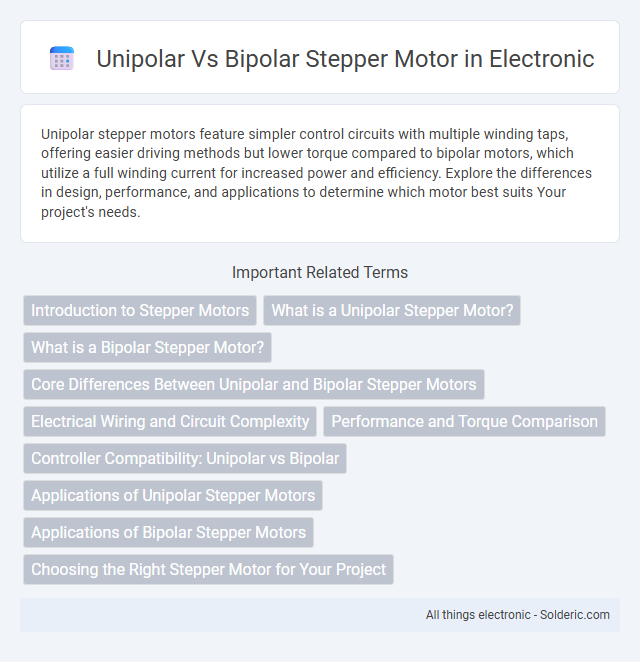Unipolar stepper motors feature simpler control circuits with multiple winding taps, offering easier driving methods but lower torque compared to bipolar motors, which utilize a full winding current for increased power and efficiency. Explore the differences in design, performance, and applications to determine which motor best suits Your project's needs.
Comparison Table
| Feature | Unipolar Stepper Motor | Bipolar Stepper Motor |
|---|---|---|
| Winding Configuration | Center-tapped windings | Simple coil windings without center tap |
| Number of Wires | 5 or 6 wires | 4 wires |
| Drive Circuit Complexity | Less complex, easier to drive | More complex, requires H-bridge drivers |
| Torque | Lower torque output | Higher torque output |
| Current Flow | Current flows through one coil half at a time | Current flows through the entire coil |
| Power Efficiency | Less efficient due to center tap | More efficient power usage |
| Control Flexibility | Limited control options | Supports advanced control modes (microstepping) |
| Applications | Simple, low torque applications | High performance, precision applications |
Introduction to Stepper Motors
Stepper motors convert electrical pulses into precise angular movements, making them essential for applications requiring accurate position control. Unipolar stepper motors feature a single winding with a center tap, allowing simpler drive circuits and easier direction reversal, while bipolar stepper motors utilize a dual-winding design for higher torque and efficiency due to full coil excitation. Understanding the structural and operational differences between unipolar and bipolar stepper motors is crucial for selecting the appropriate motor type in robotics, CNC machines, and automation systems.
What is a Unipolar Stepper Motor?
A unipolar stepper motor features a winding with a center tap on each coil, allowing current to flow in one direction through each half of the winding, simplifying control circuitry and enabling easier driver design. This design typically provides six or five wires, allowing for simpler switching but generally producing less torque compared to bipolar stepper motors. Unipolar motors are commonly used in applications requiring moderate torque and simpler control systems, such as 3D printers and small robotics.
What is a Bipolar Stepper Motor?
A bipolar stepper motor features two coils with four wires and requires current to flow in both directions through each coil, enabling stronger magnetic fields and higher torque compared to unipolar motors. Your control system must use an H-bridge driver to reverse the current polarity, allowing precise control of the motor's rotation. Bipolar stepper motors are ideal for applications demanding greater torque and efficiency, such as 3D printers and CNC machines.
Core Differences Between Unipolar and Bipolar Stepper Motors
Unipolar stepper motors feature center-tapped coils allowing simpler drive circuitry and easier control with unidirectional current flow, whereas bipolar stepper motors use a single winding per phase requiring current reversal but providing higher torque and efficiency. Unipolar motors typically have more wires (usually six or eight), while bipolar motors generally have four wires, influencing wiring complexity and control methods. The core difference lies in their coil configuration and driving technique, affecting performance, torque output, and control circuitry requirements.
Electrical Wiring and Circuit Complexity
Unipolar stepper motors feature a center-tapped winding configuration, simplifying electrical wiring by requiring fewer transistors and allowing easier driver circuit design. Bipolar stepper motors have a simpler winding but require H-bridge circuits for current reversal, increasing circuit complexity and the number of components. The simpler wiring of unipolar motors results in less complex control electronics, while bipolar motors demand more sophisticated driver circuitry to handle coil polarity changes efficiently.
Performance and Torque Comparison
Bipolar stepper motors generally provide higher torque and better performance compared to unipolar stepper motors due to the ability to use the entire winding coil, resulting in increased magnetic flux and efficiency. Unipolar motors, while simpler to control and less expensive, have lower torque output because only half of the coil is energized at a time. The choice between unipolar and bipolar stepper motors depends on the torque requirements and precision needed in applications like CNC machines or robotics.
Controller Compatibility: Unipolar vs Bipolar
Unipolar stepper motors feature a center-tapped winding design compatible with simpler controller circuits that do not require current reversal, enabling straightforward driver implementations like the ULN2003. Bipolar stepper motors demand controllers capable of reversing current flow through each winding, typically utilizing H-bridge drivers such as the L298 or dedicated bipolar stepper motor drivers for precise control. The choice between unipolar and bipolar stepper motors heavily depends on the compatibility and complexity of the control electronics, influencing torque, efficiency, and driver cost.
Applications of Unipolar Stepper Motors
Unipolar stepper motors are widely used in applications requiring precise positional control with moderate torque, such as 3D printers, CNC machines, and office automation equipment. Their simpler drive circuitry and ease of control make them suitable for low to medium power applications like printers, plotters, and small robotics. Unipolar motors are preferred in situations where cost efficiency and straightforward implementation are critical.
Applications of Bipolar Stepper Motors
Bipolar stepper motors are widely used in applications requiring high torque and precise control, such as 3D printers, CNC machines, and robotics. Their ability to deliver greater torque compared to unipolar motors makes them ideal for driving heavier loads and performing accurate positioning tasks. Your projects benefit from the efficiency and reliability of bipolar stepper motors in demanding industrial and automation environments.
Choosing the Right Stepper Motor for Your Project
Unipolar stepper motors offer simpler driving circuits and faster response times due to their center-tapped windings, making them suitable for applications requiring moderate torque and precise control. Bipolar stepper motors provide higher torque and efficiency by using the entire coil winding in each phase, ideal for projects demanding greater power and finer positional accuracy. Understanding your project's torque requirements, power supply constraints, and control complexity will help you choose the right stepper motor for optimal performance.
Unipolar vs Bipolar Stepper Motor Infographic

 solderic.com
solderic.com